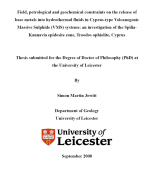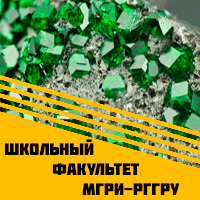Добрый день, Коллеги. Важное сообщение, просьба принять участие. Музей Ферсмана ищет помощь для реставрационных работ в помещении. Подробности по ссылке
Field, petrological and geochemical constraints on the release of base metals into hydrothermal fluids in Cyprus-type Volcanogenic Massive Sulphide (VMS) systems: an investigation of the Spilia-Kannavia epidosite zone, Troodos ophiolite, Cyprus
Полевые, петрологические и геохимические ограничения на поступление неблагородных металлов в гидротермальные флюиды в вулканогенных массивных сульфидных системах кипрского типа: исследование эпидозитовой зоны Спилия-Каннавия, офиолитовый комплекс Троодос, Кипр
Field, petrological and geochemical constraints on the release of base metals into hydrothermal fluids in Cyprus-type Volcanogenic Massive Sulphide (VMS) systems: an investigation of the Spilia-Kannavia epidosite zone, Troodos ophiolite, Cyprus
Understanding source-deposit relationships in VMS systems is important for mineral exploration and to increase knowledge of seafloor hydrothermal processes and ocean–crust fluxes. Although it is known that metals are stripped from oceanic crust by hydrothermal fluids and redeposited in orebodies, some aspects are poorly understood. It has been proposed that metal depleted epidosites (epidote–quartz–chlorite–Fe-oxide–titanite units within sheeted dyke complexes) are source rocks for Cyprus-type VMS deposits. To test this hypothesis, the Spilia-Kannavia epidosite zone in the Troodos ophiolite, Cyprus, was investigated. This zone (≥1.9 km3), at the base of the Sheeted Dyke Complex, extends ~5 km parallel and ~2 km across dyke strike and vertically ≥400 m.
Differentiation trends defined by LA-ICP-MS analysis of volcanic glass and SIMS analysis of minerals in fresh basalts indicate that olivine and pyroxene were important hosts of Co, Ni and Mn but not Cu or significant Zn. Protoliths for the Spilia-Kannavia epidosite zone were Zn rich, with moderate Mn and Co and low Cu and Ni relative to average Troodos basalts. SIMS analysis indicates that, during epidositisation, chlorite and amphibole are the only silicate minerals that retain Co, Ni and Zn, whilst epidote hosts Mn. Concentrations of Cu are low in all silicates. Base metal mobilisation was controlled by chlorite and amphibole dissolution although concentrations in chlorite and epidote vary with alteration. During alteration, the Spilia-Kannavia epidosite zone released ~0.4 Mt Zn, ~0.06 Mt Ni, ~5.2 Mt MnO, and 0.14 Mt Cu. This exceeds the Zn within any Cyprus-type VMS deposit, and provides enough Cu for a medium-large deposit. In comparison, published data suggest a similar volume of non-epidosite zone diabase could mobilise similar amounts of Zn, less Cu and Ni, and no Co or Mn, but it is not clear if all of these base metals are removed from the sheeted dyke complex. It is concluded that the epidosite zone formation is the only way to mobilise significant amounts of base metals within Cyprus-type VMS systems. <...>




